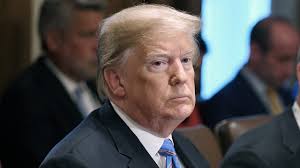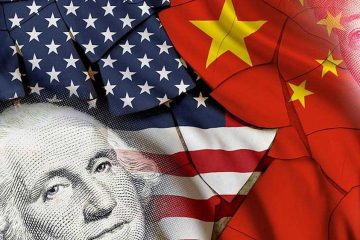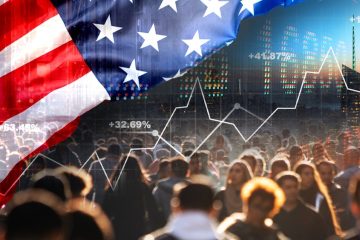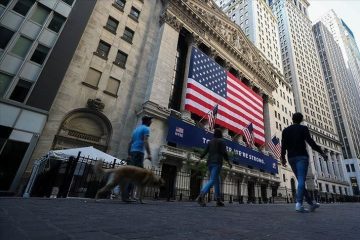Bully, Berate, Manipulate: 3 Ways Trump is Attempting to Steer the Fed to Lower Interest Rates

See that guy grimacing behind Jerome Powell? That picture was taken back when Trump nominated him to run the Federal Reserve. And that was the high point of their relationship.
Trump upped the ire Thursday in a tweet storm railing against the Fed. Among other things, Trump wrote, “The Fed’s high interest rate level, in comparison to other countries, is keeping the dollar high, making it more difficult for our great manufacturers like Caterpillar, Boeing, John Deere, our car companies, & others, to compete on a level playing field.”
Many presidents—including Trump, Kennedy, Johnson, Nixon, and the first Bush, according to multiple Fed experts, researchers, and historians—have tried to push the Fed into lowering interest rates before an election in hopes of wooing voters by goosing the economy. Under LBJ, then-chair William McChesney Martin famously said that the role of the Fed was to “take away the punch bowl [by raising interest rates] just as the party gets going.” Johnson shoved him into a wall during one discussion.
Trump hasn’t shoved anyone. But here’s what he is doing to try and steer the Fed in the direction he wants.
Appointments
This has been Trump’s least effective approach. It would take a majority of the Fed board of governors to consistently vote for lower interest rates to satisfy his desire, but the seats have staggered terms and it is difficult for one president to name a controlling majority of the board before sometime into a second term.
Trump nominated Powell as Fed chair in November 2017 and the Senate confirmed him. By November 2018, the President said he was “not even a little bit happy” with Powell because of the rate increases the Fed has undertaken over time.
Trump’s other Fed governor appointees have been seen as supporting lower interest rates but getting confirmation has been tricky. Multiple candidates—Herman Cain and Stephen Moore—were considered controversial enough that Senate approval was unlikely, so the administration withdrew their names.
The latest two candidates—Christopher Waller, director of research at the Federal Reserve Bank of St. Louis and Judy Shelton, U.S. executive director at the European Bank for Reconstruction and Development—have yet to receive a vote. But it is unclear that their inclusion will create automatic support for continued interest cuts.
Tirades
Trump has pumped forth a regular volley of criticism targeting both Powell and the Fed, whether in tweets like those on Thursday or through comments to the press. An example from June was when Trump told ABC News that U.S. GDP growth would be “at least a point and a half higher” if the Fed hadn’t increased interest rates so much in 2018.
Given the number of times rates climbed, and dropped less in July than Trump wanted, suggesting that the approach was highly effective is questionable. What it has done, however, is attract an unusual amount of potent criticism.
Former Fed chairs Paul Volcker, Alan Greenspan, Ben Bernanke and Janet Yellen took the unusual step to write rote in Monday’s Wall Street Journal that “the Fed and its chair must be permitted to act independently and in the best interests of the economy, free of short-term political pressures and, in particular, without the threat of removal or demotion of Fed leaders for political reasons.”
Weaponizing tariffs
What has been new—and potentially disturbing—is Trump’s apparent use of tariffs to indirectly manipulate interest rates.
A day after the Fed lowered interest rates on July 31 by 0.25%—and Trump upbraided Powell for not making the cut larger—the president indulged in a tirade on Twitter, but one directed at China. He claimed the country had backed out of a trade agreement and said that in retaliation the U.S. would put a 10% tariff on another $ 300 billion of goods annually from the country start Sept. 1.
“It could be coincidence,” said Steven Blitz, chief U.S. economist at investment research provider TS Lombard. “I think the timing is definitely suspicious.”
The sideways glance from Blitz and others is the result of a newly regular dynamic. Trump announces increased tariffs and uncertain markets fall. He lowers them and talks of a trade deal and the markets improve.
That’s because investors hate uncertainty. And each drop becomes a signal to the Fed that the economy might falter, which becomes one of multiple factors that could push the organization into lowering rates in an attempt to increase economic activity. As Powell said in his July testimony to Congress, “crosscurrents, such as trade tensions and concerns about global growth, have been weighing on economic activity and the outlook.”
Aside from the novel approach to monetary arm-twisting, the byproducts could be economic disaster.
“There’s no precedence in the modern world of two gigantic economies going into a trade war,” said Peter Earle, an economist at the American Institute for Economic Research. “Even in addition to what we know, there are many possibilities for unintended consequences.”
“We had tariff wars in the past, but he’s using them to pressure into bilateral agreements with individual countries,” said Sheila Tschinkel, a visiting economics professor at Emory University who has previously worked for the Federal Reserve and the International Monetary Fund. “Unfortunately, China is extremely large, which makes it risky.”
Tschinkel, who isn’t certain that tariffs are an attempt to manipulate the Fed, says that the current strategy, no matter what the reason, is a potential problem.
“When he’s acting against China, it’s making lower- and middle-income people worse off,” Tschinkel said. “When you put pressure on real income at the lower end of the income distribution, it’s more negative for the economy than on the upper end.” Money earned goes largely into spending, which stimulates the economy, and not into savings. Tariffs are consumption taxes that redirect money from the economy into government coffers.
A second danger is that repeated uncertainty can cause markets to retreat enough to become a self-fulfilling prophesy of economic weakness.
Third, and perhaps worst, is that the Fed and other central banks show that they have no mechanisms left to help the economy. Trump is assuming, “I follow my strategy on trade so even if things turn sour, I always have the Fed to reduce interest rates and bail me out,” said Raghuram Rajan, professor of finance at the University of Chicago Booth School of Business and former governor of the Reserve Bank of India and chief economist and director of research at the International Monetary Fund.
“The danger is the central banks don’t have that much ammunition to bail out … and all these unconventional policies seem to have limited and diminishing effects over time,” Rajan said. “Central bankers have to continue pretending that they can achieve their objectives because otherwise it could make things worse because of expectations.”
And so, while the central banks indeed may be dressed only in their skivvies, Trump is pushing an agenda that could backfire drastically on the economy.
More must-read stories from Fortune:
—What people get wrong about artificial intelligence and China
—Will Apple will absorb tariffs on Chinese-made products?
—Is it “only human” to feel anxious about money? Talking finance with Sophia the Robot
—The currency that’s quietly emerged as Asia’s safest bet
—Listen to our audio briefing, Fortune 500 Daily



